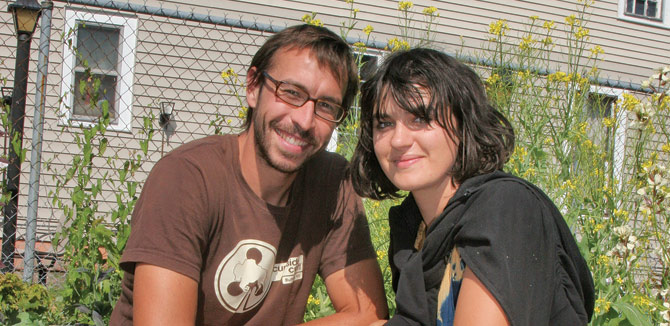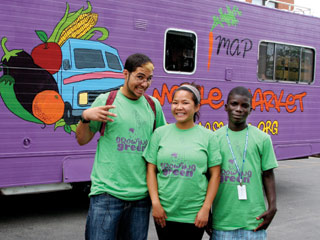Garden of Urban Delights
by Patricia Watson

Someone once described to me the reaction of visitors from a Third World country when they entered one of our supermarkets. Overwhelmed with the quantity of food, they began to cry.
In our lives, overstocked supermarkets are almost a banality. Yet there are people in Buffalo who don’t have access to fresh fruit and vegetables—people without transportation, limited in resources, or otherwise unable to get much further than a corner store for their food. People who live in what staff at the Massachusetts Avenue Project (MAP) call “food deserts,” a situation two dynamic urban farms on Buffalo’s West Side are seeking to remedy.
As of July 14, city residents began seeing a purple Winnebago driven by Cyndie Huynh with the words “Mobile Market” painted on its sides traveling the streets. Inside the Winnebago are shelves and bins full of the fresh produce grown at the Urban and Youth Farm on Massachusetts Avenue. Every Tuesday at noon, the van pulls up at Jericho Road Ministries at 184 Barton Street, where customers can purchase not only organic produce but also items such as bulk rice and lentils. On Wednesdays at 1:30pm, residents and visitors of Santa Maria Towers at 255 Connecticut Street have the same opportunity. A dietetic technician is available to advise on special diets. The food is heavily discounted, and more sites will be opening this summer.
The project began in 2002. This year, MAP will produce 3,000 pounds of food on half an acre on Massachusetts Avenue. Forty varieties of fruits and vegetables grow on eight lots—celery, spinach, collard greens, pears, apples, blueberries, raspberries, spinach, and cherries, to name just a few. Working with neighborhood youth, college interns, and the University at Buffalo, and assisted by multiple grants, MAP produces food and employs young people, teaching them how to farm, create a business plan, and sell a product.

I toured the farm with Jesse Meeder. The project is more than just gardens. The adobe greenhouse, for instance, was 97 degrees when we entered. It is made with straw and bale, eight times more insulating than traditional materials. In the middle is a newly dug pool, part of an “aquaponic” (aquaculture and hydroponic) system. Meeder hopes to farm tilapia here, and use the fish wastes to fertilize the plants on “grow beds,” which will in turn provide clean water back to the fish. He chose tilapia because the big fish don’t eat the little ones. He hopes to produce 2,000-3,000 pounds of food in 450 square feet.
Outside, the beds are raised. Improving the soil remains a constant challenge. Meeder uses worms and worm castings as part of that effort. A giant compost heap helps, too. Rainwater is captured in a 1,000-gallon rain barrel.
Zoe Hollomon helps to figure out how to get all that produce to the community, and make enough money to sustain the farm. She runs Youth Enterprise, where youths aged 14-17 learn business skills. At a packing house in Rochester, the teens chop and package MAP’s produce, as well as some purchased at Porter Farms, to create their Amazing Chili Starter, a wet mix for soup and chili, and their Super Duper Salsa. Twelve local stores carry these products, including Globe Market, Chateau Buffalo, the Lexington Co-op. Check them out. I received the chili starter as a gift, and it gave a great flavor to a batch I made.
The youth also market door to door and at farmer’s markets, including those at Bidwell Parkway and Roswell Park. There is a farm stand at 389 Massachusetts Avenue. Go over and take a look at the operation. You’ll see little signs in some of the raised beds. For a $100 donation, supporters can have their names on the signs, receive garden updates from the kids, and even be invited to a summer barbecue.
To learn more about MAP, visit www.mass-ave.org. August 3-7 is Be Vocal, Eat Local week, so look for events around the community promoting local food.
Not too many blocks away from MAP is CurbSide Croft, “your corner farm,” another model of urban farming in the heart of the diverse West Side. On one northern corner of Vermont and West is an organic vegetable garden; on the other is a budding specialty shrub venture. This may be the definition of a labor of love—love of the earth, of food, and of people. Emily Gadanyi created and nurtured this concept, beginning at a greenhouse in Lackawanna, where she painstakingly planted, in soil pots she had made, 3,500 organic seeds for her urban farm.

In November 2008, Gadanyi set out to demonstrate that an urban farm can be a viable economic model, keeping copious records so others could replicate her successes and avoid her mistakes. She and her husband, Brandon Majewski, spent the winter rounding up compost, coconut shells, ladybugs, and worms for their recipe for healthy, organic growing matter. Their CurbSide Croft t-shirts (for sale at www.curbsidecroft.com) express their wish: “Imagine small farms everywhere.”
Emily has chosen her vegetables carefully, using organic and heirloom varieties, and considering the diets of the neighborhood. She has planted crops for refugees from Burma and parts of Africa, offering them familiar ingredients. There is lemongrass, Thai basil, and red komatsuna. She plans to see what sells, and to accommodate the desires of her neighbors.
Her plot is laid out in what is called mandalas, where circles of mounded earth and compost economize on space in a way that straight rows cannot. This arrangement also makes it easier to get from plot to plot, and to companion plant varieties that will help each other thrive while warding off pests and predators. She believes that the groomed, geometric shapes are refreshing to the neighbors, a counterpoint to any chaos they may experience in their lives. A wild foraging garden, for example, wouldn’t generate the same emotional response. Her plant choices also reflect her thoughtful intelligence. There is borage to attract bees, and New Zealand spinach, which is heat tolerant and doesn’t get bugs. She pulled off a leaf of that spinach for me to taste, trying to describe its unique flavor. It was crunchy, and full of moisture, popping as I chewed. Delicious. And her nasturtiums! The petals are little peppery morsels, leaving their tang in the back of your throat.
Throughout the garden are large plastic barrels for growing potatoes. Emily puts some soil and compost in the bottom, and then layers the potato seed on top. When little shoots come up, she adds more soil and compost, and another layer of potato seed. She repeats this until the barrel is full. On the topmost layer she plants beans, to deter pests. Ultimately, when the plants have matured, the barrel gets dumped, and it will be full of potatoes. I found this idea so inspiring I went home and found a small barrel. I had some potatoes in the kitchen already. They were full of little sprouts, so I cut them up and put them on top of some soil in the container. The nice part is that the barrel can be kept in the driveway so the potatoes don’t use up precious garden space. Can’t wait to see how it goes.
Across from the vegetable farm, Emily has begun to grow specialty shrubs such as hydrangea, viburnum, and lilac. The market for her “woody floral venture” will be local florists and nurseries. Those sales should help her balance the books, as the prices on her vegetables are low.
And just to round out the food picture, there is an adobe oven on the lot, in which Emily and Brandon will be baking bread.
Curbside Crofts opened for business on July 4. Hours vary, but are tentatively set at Tuesday and Thursday 4-6pm, and Saturday 10am-noon. Bring your own bag. For more information, visit www.curbsidecroft.com.
blog comments powered by Disqus
|
Issue Navigation> Issue Index > v8n29 (The Food Issue: week of Thursday, July 16, 2009) > Garden of Urban Delights This Week's Issue • Artvoice Daily • Artvoice TV • Events Calendar • Classifieds |









 Current Issue
Current Issue